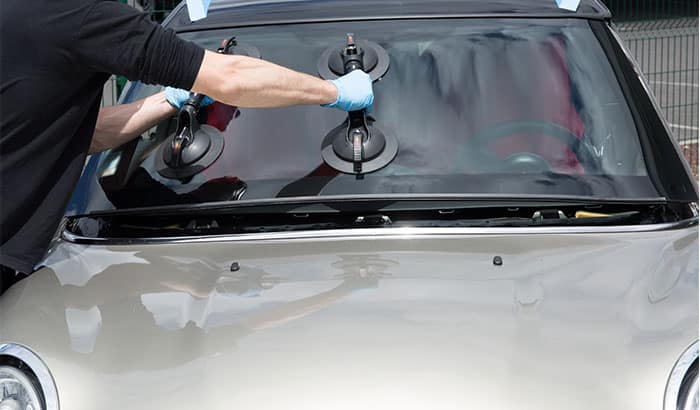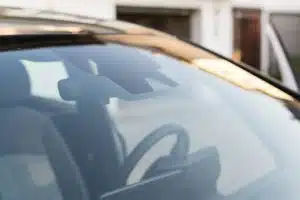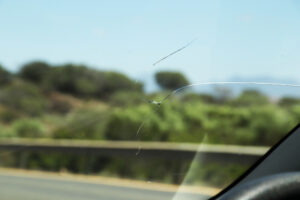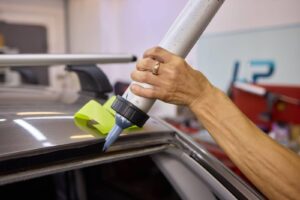Are you in a situation where you need a windshield replacement but are unsure how to proceed? Don’t worry! This article offers a detailed step-by-step guide covering everything you need to know about getting a windshield replacement from beginning to end.
However, it’s possible that you may not even be aware that you require a new windshield. If that’s the case, there are some signs to look out for.
Here are some indicators that suggest you may need to replace your windshield:
- Size and severity of the damage: The extent and severity of the damage are crucial factors in determining whether you need a new windshield. Generally, replacement is recommended if the crack is longer than 12 inches or if there are multiple cracks and chips. Large cracks can obstruct your vision and compromise the windshield’s structural integrity.
- Location of damage: The location of the damage on your windshield is important for assessing whether replacement is necessary. Cracks or chips that obstruct the driver’s line of sight, especially in the critical viewing area, pose a safety hazard and typically require replacement. Additionally, damage near the windshield’s edges can weaken the glass’s overall integrity and bonding to the frame.
- Damage in the driver’s field of vision: Even small cracks or chips in the driver’s line of sight can be distracting and compromise visibility. The slightest damage in this area can cause glare or distortions, making it difficult to see the road clearly. In such cases, replacement is recommended to ensure clear visibility and safe driving.
- Spreading cracks: Cracks on a windshield can spread over time due to various factors, such as temperature changes, vibrations from driving, or even the stress of the initial impact. If you notice the cracks expanding or spreading, it’s crucial to have your windshield inspected by a professional. They can assess the extent of the damage and recommend replacement if necessary, as spreading cracks can compromise the structural integrity of the glass.
- Depth of damage: The depth of the damage is an important consideration when deciding if replacement is needed. If you can feel the damage with your fingernail or if the damage has penetrated through the entire thickness of the windshield, it may be necessary to replace it. Deep cracks or chips weaken the glass, leading to further damage or sudden windshield failure.
- Previous unsuccessful repairs: If you have had previous attempts to repair the windshield that haven’t been successful or if the damage has worsened after a repair, replacement may be necessary. Failed repairs can compromise the integrity of the glass, making it more susceptible to further damage or complete failure.
- Pitting or extensive damage from debris: Windshields can sustain pitting or extensive damage from debris such as rocks or gravel on the road. Pitting refers to the small, shallow divots that occur from the impact of debris.
Extensive damage or severe pitting can compromise the strength and clarity of the windshield. In such cases, replacement may be the best course of action to restore optimal visibility and ensure the windshield’s structural integrity.
- Damage to the windshield’s edges: Damage near the edges of the windshield can weaken the overall integrity of the glass and its bonding to the frame. The edges are critical in maintaining the windshield’s stability and preventing water leakage. If the damage extends to the edges, it can compromise the sealing and stability and determine whether you need a new windshield.
- Inspection by a professional: If you’re uncertain about the severity or extent of the damage, it’s advisable to consult a professional windshield technician. They have the expertise and experience to assess the damage accurately.
A professional inspection can consider various factors, including the damage’s size, location, depth, and spread of the damage, helping you make an informed decision about whether repair or replacement is necessary.
Prioritizing your safety and the safety of others on the road is imperative. If you suspect your windshield is compromised or damaged, it’s best to seek professional advice promptly. They can thoroughly assess the damage and recommend the appropriate course of action, whether it’s repair or replacement, to ensure optimal visibility, structural integrity, and overall safety.
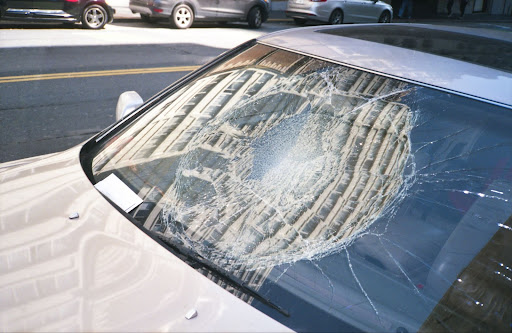
Step-By-Step Guide: What To Do if You Need a New Windshield
Step 1: Assess the Damage
Thoroughly inspect your windshield to determine the type and extent of the damage. Look for cracks, chips, or any other signs of damage. Note the damage’s size, location, and shape, which will help determine whether repair or replacement is necessary.
Step 2: Research Reputable Windshield Replacement Providers
Do comprehensive research to find reputable windshield replacement providers in your area. Consider their reputation, customer reviews, certifications, and years of experience. Look for companies specializing in windshield replacements with a track record of quality work.
Step 3: Get Multiple Quotes
Contact several windshield replacement providers and request quotes for the service. Provide them with accurate and detailed information about your vehicle, including the make, model, year, and any specific features or options that may affect the replacement process. Compare the quotes, considering the cost, warranty, and reputation of the provider.
Step 4: Review Your Auto Insurance Policy
Review your policy to determine if windshield replacement is covered. Some insurance plans offer comprehensive coverage that includes windshield damage. Check for any deductibles or limitations on coverage. If your insurance covers windshield replacement, inquire if they have preferred providers or if they require pre-authorization.
Step 5: Schedule an Appointment
Once you have selected a reputable provider, schedule an appointment for the windshield replacement. Discuss the availability of appointments, the estimated duration of the service, and any specific instructions or requirements for the appointment. Choose a date and time that is convenient for you.
Step 6: Prepare Your Vehicle for the Windshield Replacement
Remove personal belongings from the dashboard, seats, and floor to ensure unobstructed access to the windshield area. Clear out any items attached to the windshield, such as parking permits or toll tags — this will help the technicians work efficiently and protect your belongings.
Step 7: Arrive at the Scheduled Time for Your Appointment
If you have chosen a service center, park your vehicle in a designated area. If you have opted for a mobile service, ensure your car is parked in a safe and accessible location where the replacement can be performed. Provide any necessary access codes or instructions if needed.
Step 8: Removal of the Damaged Windshield
The technicians will begin by inspecting the damage and determining the best approach for removal. They will use specialized tools and techniques to remove the damaged windshield carefully. They will take precautions to avoid further damage to your vehicle, such as protecting the surrounding areas with appropriate coverings.
Step 9: After the Removal of the Windshield
Once the damaged windshield is removed, the technicians will prepare the frame for the installation of the new windshield. They will clean the frame, removing any debris or adhesive residue. Before proceeding with the installation, they will also address any underlying issues, such as rust or corrosion.
Step 10: Installation of the New Windshield
The technicians will install the new windshield using precise techniques and high-quality adhesive. They will ensure it fits properly and aligns with the vehicle’s structural integrity. The adhesive should meet or exceed industry standards to ensure a strong and secure bond.
Step 11: Curing and Cleaning
After installing the new windshield, the adhesive requires time to cure. The technicians will follow the manufacturer’s recommended curing time, which typically ranges from one to twenty-four hours. During this period, it is important to avoid driving the vehicle or exposing it to extreme temperatures or excessive moisture. The technicians will also clean the exterior and interior of the windshield, removing any adhesive residue, fingerprints, or smudges.
Step 12: Final Inspection
The technicians will conduct a final inspection to ensure the windshield is installed correctly and meets all safety standards. They will check for proper alignment, sealing, and any visible defects. The technicians may provide instructions on post-installation care, such as avoiding car washes or using excessive force on the windshield for a certain period. They may also explain the warranty terms and provide you with documentation.
Step 13: Payment and Paperwork
Complete the payment process as per the agreed terms. Review any paperwork, including invoices, warranties, or guarantees, and ensure accurate details. Keep a copy of all documentation for your records, including the warranty information from the provider.
Following these detailed steps will help you navigate the process of getting a new windshield. Finding a reputable provider, understanding your insurance coverage, and ensuring proper installation will contribute to a safe and satisfactory windshield replacement experience.
If you are ready to get started, here are some things you should consider before hiring an auto glass professional:
- Experience and Expertise: Look for professionals with extensive experience in the auto glass industry. Consider their expertise in handling different types of vehicles and windshield replacements.
- Reputation and Reviews: Check their reputation through online reviews, testimonials, and ratings from previous customers. Positive feedback and recommendations are indicators of a reliable and reputable professional.
- Certification and Training: Ensure the auto glass professional has the necessary certifications and training. Look for certifications from recognized organizations demonstrating their knowledge and skills in windshield replacements.
- Quality of Materials: Inquire about the quality of the materials they use for windshield replacements. High-quality materials ensure durability, clarity, and proper sealing of the windshield.
- Warranty: A reputable auto glass professional will offer a warranty on their work and the materials used. Ensure that they provide a warranty covering any potential defects or issues arising after the replacement.
- Insurance Coverage: Check if the professional works with insurance companies and if they can handle the insurance claim process on your behalf. This can help streamline the payment and reimbursement process.
- Mobile Services: If you prefer convenience, consider professionals who offer mobile services. They can come to your location to replace the windshield, saving you time and effort.
- Timeliness and Availability: Inquire about their availability and turnaround time. Prompt service is essential to replace your windshield quickly, especially if the damage affects your visibility or safety.
- Cost and Quotes: Compare quotes from different professionals to ensure you get a fair price. However, remember that the cheapest option may not always provide the best quality. Balance cost with the reputation and quality of the professional.
- Customer Service: Evaluate their level of customer service, including their responsiveness, professionalism, and willingness to answer your questions and address your concerns.
Considering these key factors will help you find a skilled and reliable auto glass professional who can ensure a successful and satisfactory windshield replacement experience.
Leave Your Windshield Replacement to the Professionals at Utah Mobile Auto Glass
Whatever windshield issue you face, the best thing to do is leave windshield replacement or repairs to a professional, which is where Utah Mobile Auto Glass comes in.
We have trained technicians ready and willing to share their knowledge and expertise with you about alleviating your windshield woes. Contact us online or at 801-997-9161, and let’s replace your windshield today!


